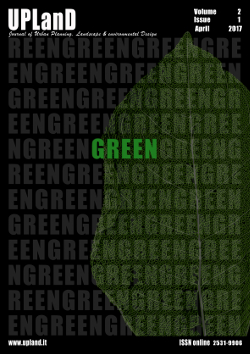Green for the regeneration in sustainable urban planning
Main Article Content
Abstract
This work proposes a method for urban planning aimed at pursuing the sustainable regeneration of the central neighborhoods of the city through the reorganization of settlement patterns and the protection of its environmental heritage and biological resources. The design approach uses green spaces in all their various forms, increasing soil permeability, with a connecting system of the public spaces and institutions, increasing the energy efficiency of buildings and renewable sources in order to transform the city into a complex productive, livable and sensitive ecosystem. The application of the method focuses on the famous Barrios Pueblos of Güemes and Observatorio which are threatened by a flawed urban legislation that allows for the exclusive vertical development of residential buildings, thus affecting the urban equilibrium of these areas of significant historical value. The planning support methodology focuses on all the aspects related to the wider use of green materials within the city.
Downloads
Article Details

This work is licensed under a Creative Commons Attribution-NonCommercial-NoDerivatives 4.0 International License.
Authors who publish with this journal agree to the following terms:- Authors retain copyright and grant the journal right of first publication with the work simultaneously licensed under a Creative Commons Attribution License that allows others to share the work with an acknowledgement of the work's authorship and initial publication in this journal.
- Authors are able to enter into separate, additional contractual arrangements for the non-exclusive distribution of the journal's published version of the work (e.g., post it to an institutional repository or publish it in a book), with an acknowledgement of its initial publication in this journal.
- Authors are permitted and encouraged to post their work online (e.g., in institutional repositories or on their website) prior to and during the submission process, as it can lead to productive exchanges, as well as earlier and greater citation of published work (See The Effect of Open Access).
References
De Wilde, S., & Van Den Dobbelsteen, A. (2004). Space use optimisation and sustainability. Environmental comparison of international cases. Journal of Environmental Management, 73, 91–101.
Diappi, L. (2000). Sostenibilità urbana: dai principi ai metodi di analisi, forma urbana, energia e ambiente, Torino, IT: Paravia Scriptorium.
Diaz Terreno, F. (2011). Los territorios Periurbanos de Córdoba. Entre lo genérico y los específico. Revista Iberoamericana de Urbanismo, 5.
European Commission (2012). The Multifunctionality of Green Infrastructure. Science for environmental policy.
Ewing, R., & Rong F. (2008). The impact of urban form on residential energy use. Housing Policy Debate, 19(1), 1-29.
Fasolino, I. (2014). Scenari per il governo del territorio e la sostenibilità insediativa. EyesReg, 5(3).
Fasolino, I., Grimaldi, M., & Calicchio, P. (2014). Un modello per la progettazione urbanistica di insediamenti sostenibili. Urbanistica Informazioni, 257, 32-34.
Gisotti, G. (2007). Ambiente urbano. Introduzione all’ecologia urbana. Palermo, IT: Dario Flaccovio Editore.
Jacobs, H.M. (1997). Programmi di trasferimento dei diritti edificatori in USA: oggi e domani. In L. Fusco Girard (ed.), La perequazione urbanistica: esperienze e questioni. Urbanistica 109, 62-65.
Hollnagel, E., Nemeth, C. P., & Dekker, S. (2008). Resilience Engineering Perspectives (Ashgate Studies in Resilience Engineering). Ashgate Publishing Company.
Honjo, T., & Takakura, T. (1991). Simulation of thermal effects of urban green areas on their surrounding areas. Energy and Buildings, 15(4), 43-446.
Malcevschi, S. (2010). Reti Ecologiche Polivalenti. Infrastrutture e servizi ecosistemici per il governo del territorio. Milano, IT: Il Verde Editoriale.
Municipalidad de Córdoba (2008). Bases para el Plan Director de la Ciudad de Córdoba. Lineamientos y Estrategia general para el reordenamiento del territorio - Córdoba2020. Córdoba, Argentina.
Murillo, F., & Schhweitzer, M. (2011). Planear el Barrio. Urbanismo participativo para construir el derecho a la ciudad. Buenos Aires, AG: Cuentahilos Ediciones.
Murillo F. (2013). La Brújula de la Planificación Urbana-Habitacional. Manual de orientación de intervenciones barriales con un enfoque de derechos humanos. Buenos Aires, AG: Cuentahilos Ediciones.
Jaeger J.A.G., et.al. (2010). Suitability criteria for measures of urban sprawl. Ecological Indicators, 10(2), 397-406.
Schwarz, N. (2010). Urban form revisited. Selecting indicators for characterising European cities. Landscape and Urban Planning, 96 (1), 29- 47.
Sgobbo, A. (2016). Recycling, waste management and urban vegetable gardens. WIT Transactions on Ecology and The Environment, 202, 61-72. doi:10.2495/WM160071
Sgobbo, A., & Moccia, F. D. (2016). Synergetic Temporary Use for the Enhancement of Historic Centers: The Pilot Project for the Naples Waterfront. TECHNE Journal of Technology for Architecture and Environment, 12, 253-260. doi:10.13128/Techne-19360
UN - United Nations (2012). Resilient People, Resilient Planet. A future worth choosing (Overview), UN High Level Panel on Global Sustainability, New York.
UNI - Ente italiano di normazione (2014), Linee Guida per lo sviluppo sostenibile degli spazi verdi. Pianificazione, progettazione, realizzazione e manutenzione, UNI/PdR 8:2014

